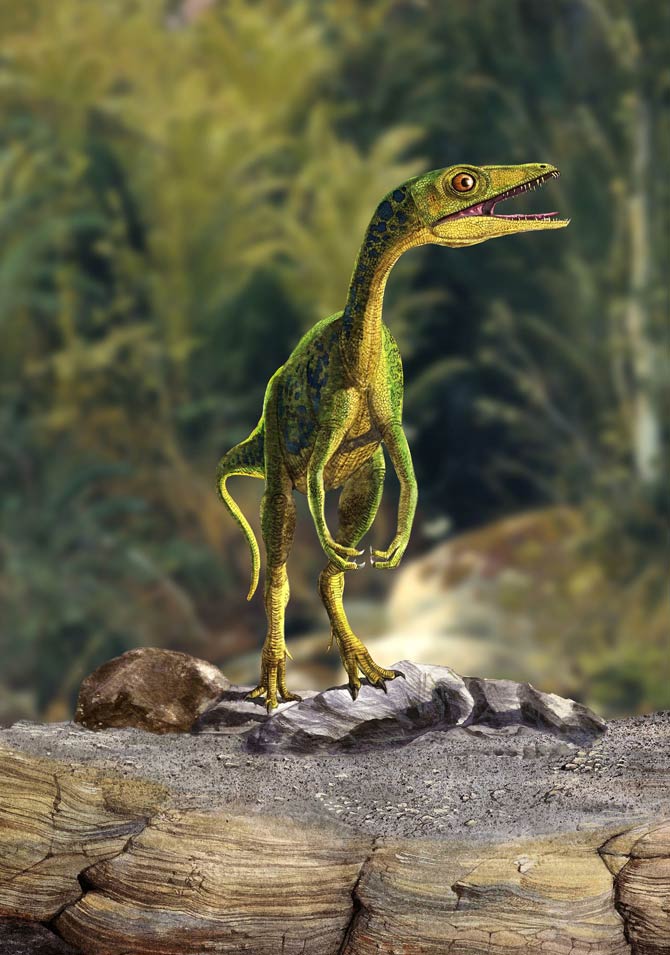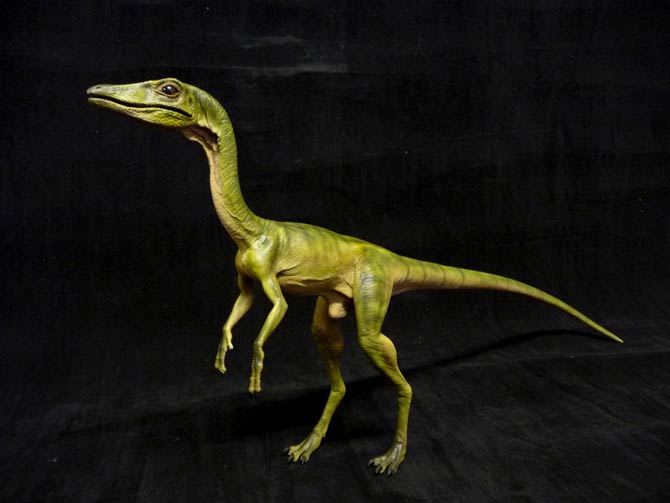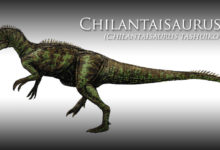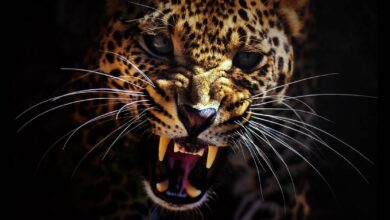Compsognathus – one of the smallest dinosaurs
Not all predatory dinosaurs were giants like the tyrannosaur. Millions of years ago, there were also reptilian predators the size of chickens, and they fed on large insects and vertebrates the size of mice. Compsognathus reached the size of a turkey and, like most theropods, was a two-legged carnivore. It lived in the Late Jurassic, 150.8 Ma.

Characteristic
The agile little predator Compsognathus (from Greek: “beautiful/delicate jaw”) was one of the smallest known dinosaurs. It had a delicate, almost bird-like structure – a narrow, pointed head, small but sharp teeth in the jaws, a flexible neck, a tight body, quite a long tail. The legs were long and birdlike.
Compsognathus had short arms with three strong fingers and a relatively long but thin skull. The tail is only partially preserved in both fossils. The related Sinosauropteryx had the proportionally longest tail of all known theropods with over 60 caudal vertebrae, whereby it is assumed that Compsognathus had a similarly long tail.
As in other related genera had the skull five paired cranial window, the eye socket (orbital window) was the largest. The lower jaw was thin, with the lack of a mandibular window – an opening in the lower jaw commonly found in archosaurs. The teeth were small but sharp, which made them adapt to prey, which consisted of small vertebrates and perhaps other small animals such as insects.

Feathers and connection with birds
For a whole century, Compsognathus was the only well-known small theropod – this also led to comparisons with Archeopteryx and to speculations about a relationship with birds. Indeed, Compsognathus, rather than Archeopteryx, aroused Huxley’s interest in the origins of birds.
Compsognathus and Archaeopteryx have many similarities in shape, size and proportions – so many that at least one featherless skeleton of an Archaeopteryx was mistaken for that of a Compsognathus for many years. Many other theropods like Deinonychus, Oviraptor or Segnosaurus are now considered to be even closer relatives of the birds.
None of the Compsognathus fossils show imprints of feathers or feather-like structures – in contrast to Archaeopteryx, which comes from the same sediments; thus, many pictures show Compsognathus without feathers. The only feathers known from Archaeopteryx are the large tail and flight feathers; short feathers, which probably covered the body, have not been preserved.

Occurrence
Compsognathus lived on the same semi-arid islands of the archipelago in what is now Europe as the oldest known bird, Archaeopteryx. The skeletons of both animals are so similar that, in some cases, scientists have considered some of the remains of the primeval bird to be Compsognathus’ bones, since no clear imprints of the feathers have been preserved.
Discovery
Only two fossil specimens are known: the Compsognathus from southern Germany is the size of a chicken [89 cm (35 in) long] and appears to be a (young) half-grown specimen, the other, from south-eastern France [125 cm (49 in) long], with finally shaped adult dinosaur bones, was the size of a turkey. Compsognathus’ teeth have also been found in Portugal.
The specimen found in Germany is the first fully preserved fossil of a dinosaur to be discovered, although it was initially attributed to a lizard. The only known species ( type species ) is Compsognathus longipes, although the specimen discovered in France was previously listed as a separate species, Compsognathus corallestris.
Even so, Compsognathus may have been the archipelago’s largest predator. The semi-arid islets had too little vegetation for a sufficient number of large herbivores to satisfy the appetites of larger carnivores.

Hunting and preys
We can imagine Compsognathus creeping in the undergrowth looking for the slightest movement of large insects, lizards, or mammals the size of a mouse. It could outrun the lizards and catch up with the young bird, if it could surprise it on the ground. In the morning, lizards basking in the sun were easy prey, still numb from the night chill. Compsognathus probably held larger prey with its front paws; the claws were not sickle-shaped tools to inflict wounds. The smaller prey was swallowed in its entirety.
Compsognathus – myths
The compsognathus is widely known as a chicken-sized dinosaur, though it actually grew larger. Despite this, many popular science books still describe him as the smallest dinosaur, although it was not the smallest dinosaur. Compsognathus is one of the few dinosaurs whose diet is known from fossil finds – the remains of small, agile lizards were found in the bellies of both individuals. This small theropod occurred in the Jurassic period, about 150 million years ago.

Detailed data / dimensions (size)
Compsognathus
- Length: 125 cm (49 in)
- Weight: up to 3.5 kg (7.7 lb)
- Speed: 64.4 km/h (40 mph)
- Lived: Late Jurassic, 150.8 Ma
Classification
- Clade: Dinosauria
- Clade: Saurischia
- Clade: Theropoda
- Family: †Compsognathidae
- Subfamily: †Compsognathinae
- Genus: †Compsognathus
- Type species: †Compsognathus longipes
- Synonym: †Compsognathus corallestris

Compsognathus – interesting facts
- The Compsognathus was popularized by Steven Spielberg in the movie Jurassic Park.
- The compsognathus was one of the smallest dinosaurs – it was about 1 m – 1.25 m (3.3 4.1 ft) – long.
- For many years it was considered the smallest dinosaur. Recently, however, even smaller non-avian dinosaurs such as the Microraptor and the Epidendrosaurus (Scansoriopteryx) have been discovered.
- For many years, the Compsognathus was considered the dinosaur most closely related to birds.
- The Compsognathus weight is estimated to be around 2-3 kg (4.4 – 6.6 lb).

Recommended
- The longest dinosaurs. Sauropods Top 10
- The heaviest dinosaurs – Top 10
- The longest predatory dinosaurs. Theropods Top 10
- The heaviest predatory dinosaurs Top 10
- The longest Ornithischians (Ornithischia) TOP 10
- The heaviest Ornithischians Top 10
- The largest raptors (dromaeosaurs) Top 10
- The heaviest Dromaeosaurids / dromaeosaurs – Top 10
- The longest Ankylosaurus Top 10
- The heaviest Ankylosaurus Top 10
- The longest ceratopsians
- The heaviest cerapsians
- The longest and largest ornithopods
- The heaviest ornithopods Top 10
- The longest Stegosaurians (Stegosauria) TOP 10
- The heaviest Stegosaurians (Stegosauria) Top 10
- The smallest sauropods Top 10
- The smallest dinosaurs Top 10
- The largest pterosaurs Top 10
- Dinosaurs
- Dinosaurs database
- Predatory dinosaurs
- Animals & dinosaurs records
- The fastest animals – Top 100
- The fastest birds – Top 10


















